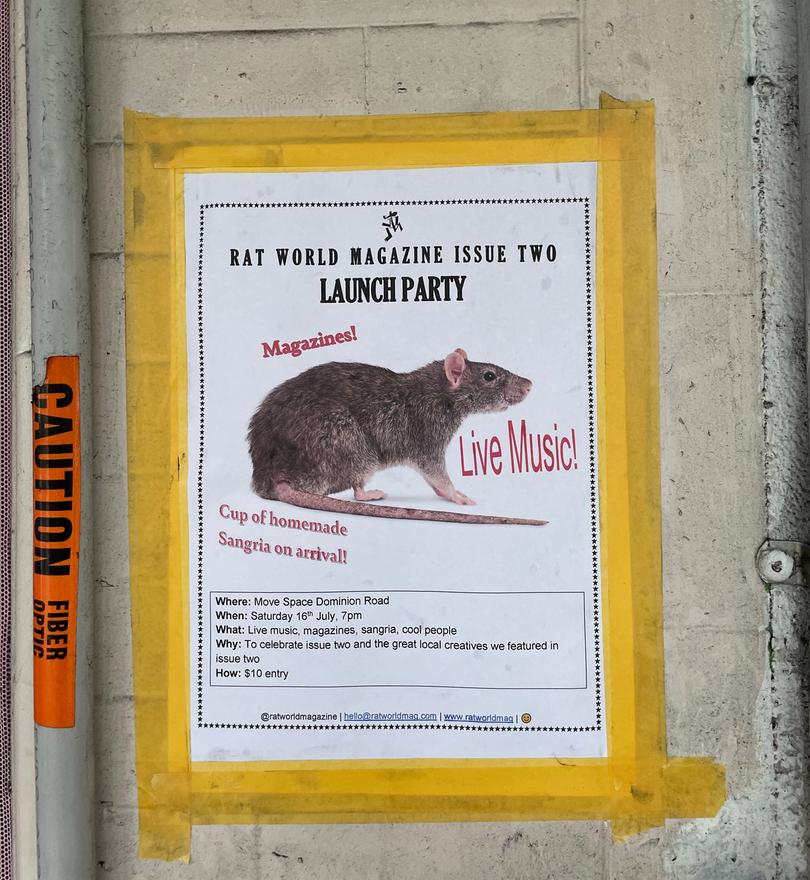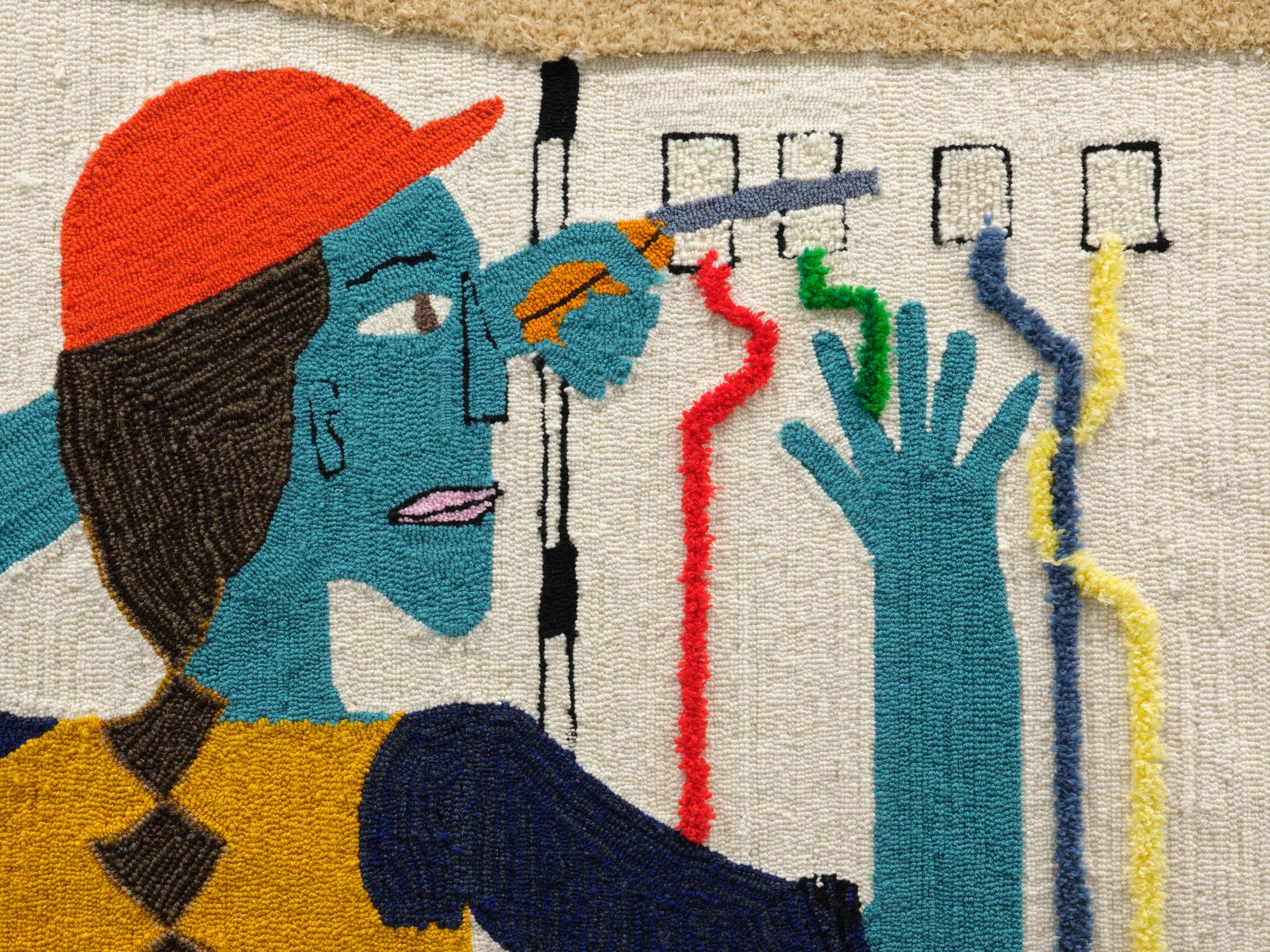
Abel Mercer considers the difficult lives of great artists, among them Octavia E. Butler, Amy Winehouse, Janet Frame and Karen Dalton — empathetic to the struggle of all artists ‘to make room for one’s own creativity’.
This essay was originally published in Past the Tower, Under the Tree: Twelve stories of learning in community, edited by Balamohan Shingade and Erena Shingade (Gloria Books, 2023).
I might have written here of my greatest teachers, the mentors who’ve taught me the most and made me who I am. Instead, I want to write about one of my old writing tutors, a teacher I wasn’t close with at all. He was a man I guess to have been in his sixties at the time, a critically acclaimed author whose books never sold in high numbers. I neither idolised nor detested him. I was twenty.
Almost the only thing I remember about this tutor’s teaching is that one day he told the class,
Don’t write. Don’t write if you can find anything else to do.
It jolted me. He was saying just the opposite of what you expect a teacher to say.
The tutor said that writing was ‘too hard’, and I think he was talking about his life being hard financially. Come to think of it, though, he might also have meant that writers don’t get the respect they deserve from society, or that the quest to achieve artistic satisfaction with one’s own work creates a life that becomes ‘too hard’. These are three kinds of validation that artists might seek or might feel they lack. One form of validation can often be confused for another, although they are technically unrelated.
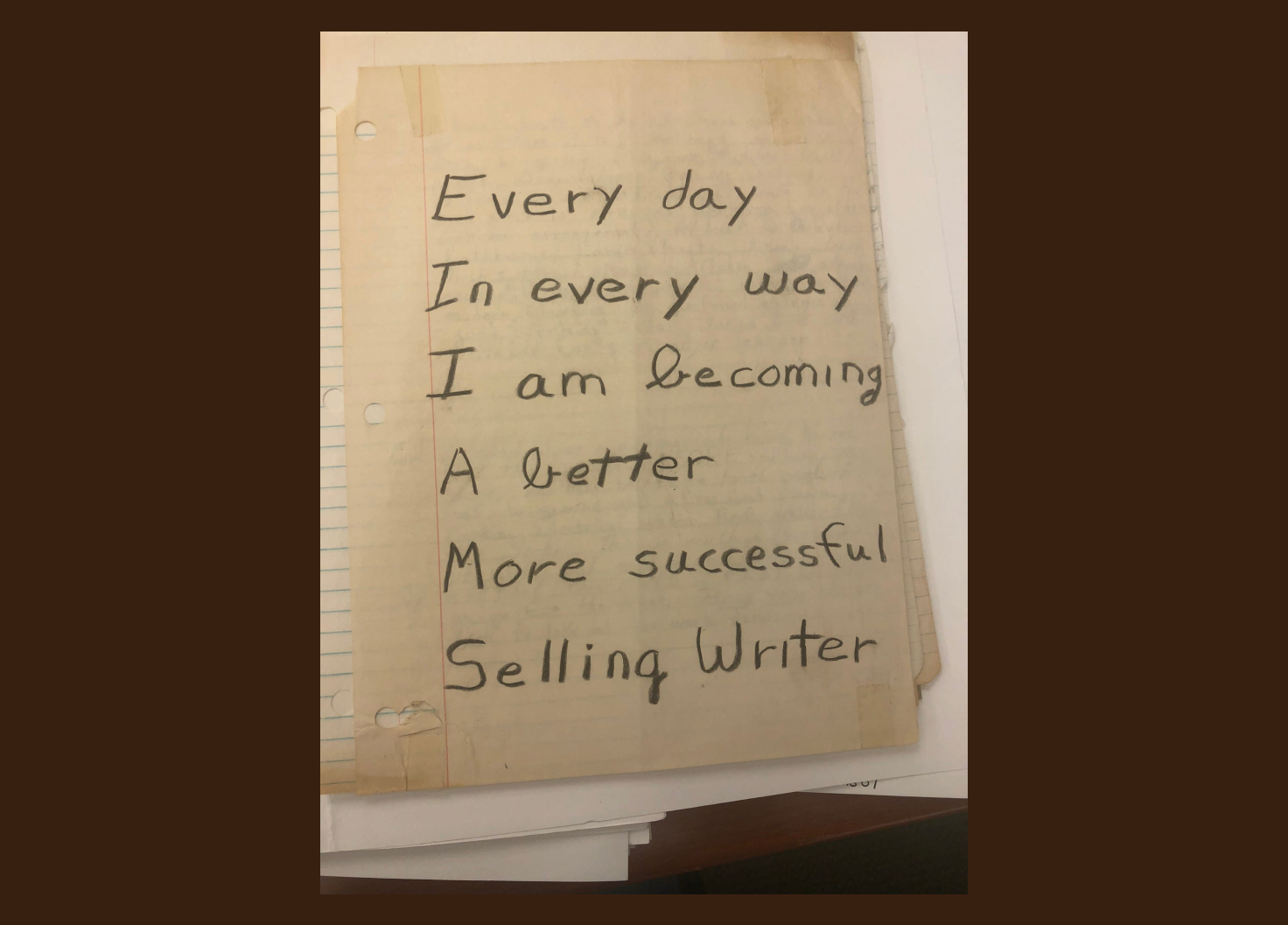
An affirmation among Octavia Butler's notes. The Huntington Library (OEB 1512)
Photo by Jillian Hess
I realise now, looking back, that I can’t say for sure what my tutor meant when he told his students not to write. I didn’t know him. The memory I have of that moment is really a story I’ve told myself about what I glimpsed there and then — on his face, in his eyes, in the tone of his voice and in his posture — a story based on other stories heard long before that day: a lifetime of myths and hearsay about what it means to be an artist. That moment in that classroom became an emblem to me of a certain reality: that there are two sides to being an artist. First, there is practising the craft, indulging what Octavia E. Butler calls the ‘positive obsession’ for our work.1 But ‘doing’ the ‘art’ is only half, or even less than half, of the equation. There is another side, the side of facing the practicalities of securing time and space in which to create and practice. My formal education has certainly lacked lessons in how to ‘do’ the practical side of things. At least, I think it has. It also seems possible that whatever part of that would-be education came my way over the years went in one ear and out the other. Maybe I only heard what fit into my story: the one I’d been told by others and by myself, of who and what I was and where I was going and what I would need on my journey. My Autobiomythography as an Artist.
That moment in that classroom became an emblem to me of a certain reality: that there are two sides to being an artist.
The financial challenges of securing space for creation loom large for many artists. As Virginia Woolf put it, ‘Poetry depends on intellectual freedom’ and ‘intellectual freedom depends on material things’.2 Material hurdles are a primary, fundamental form of obstacle with which most of us must grapple, at least for a period of proverbial ‘hungry years’ and perhaps for a lifetime. Woolf, of course, famously argued that the writer needs ‘a room of her own’ in which to write. It is worth remembering, though, that she argued not simply for a room, but also for ‘a lock on the door’ of that room — and money. For Woolf, the money ‘stands for the power to contemplate’ and ‘the lock on the door means the power to think for oneself’.3
The struggle to make room for one’s own creativity isn’t only a material one, though. As Carmel Bird writes, ‘all along the way’ when writing ‘you will have to preserve your courage because everyday life puts obstacles constantly in your way’.4 For Bird, learning to say ‘not now’ in everyday life ‘so that you can get on with your work’ is so fundamental to creative success that she entitled her 1994 writing guide Not Now Jack—I’m Writing a Novel.
It is also possible that when money arrives it doesn’t assuage financial anxiety, perhaps because the anxiety is already too deeply engrained. Unexpectedly winning $295,000 at the age of forty-eight ‘only convinced’ Octavia Butler ‘that a different, higher amount of money would be required for her security’.5 She’d already lived most of her life ‘on the edge of bankruptcy’.6 At the time of her death, ten years later, Butler believed that ‘she needed to write at least two more books in order to survive’.7
The struggle to make room for one’s own creativity isn’t only a material one, though.
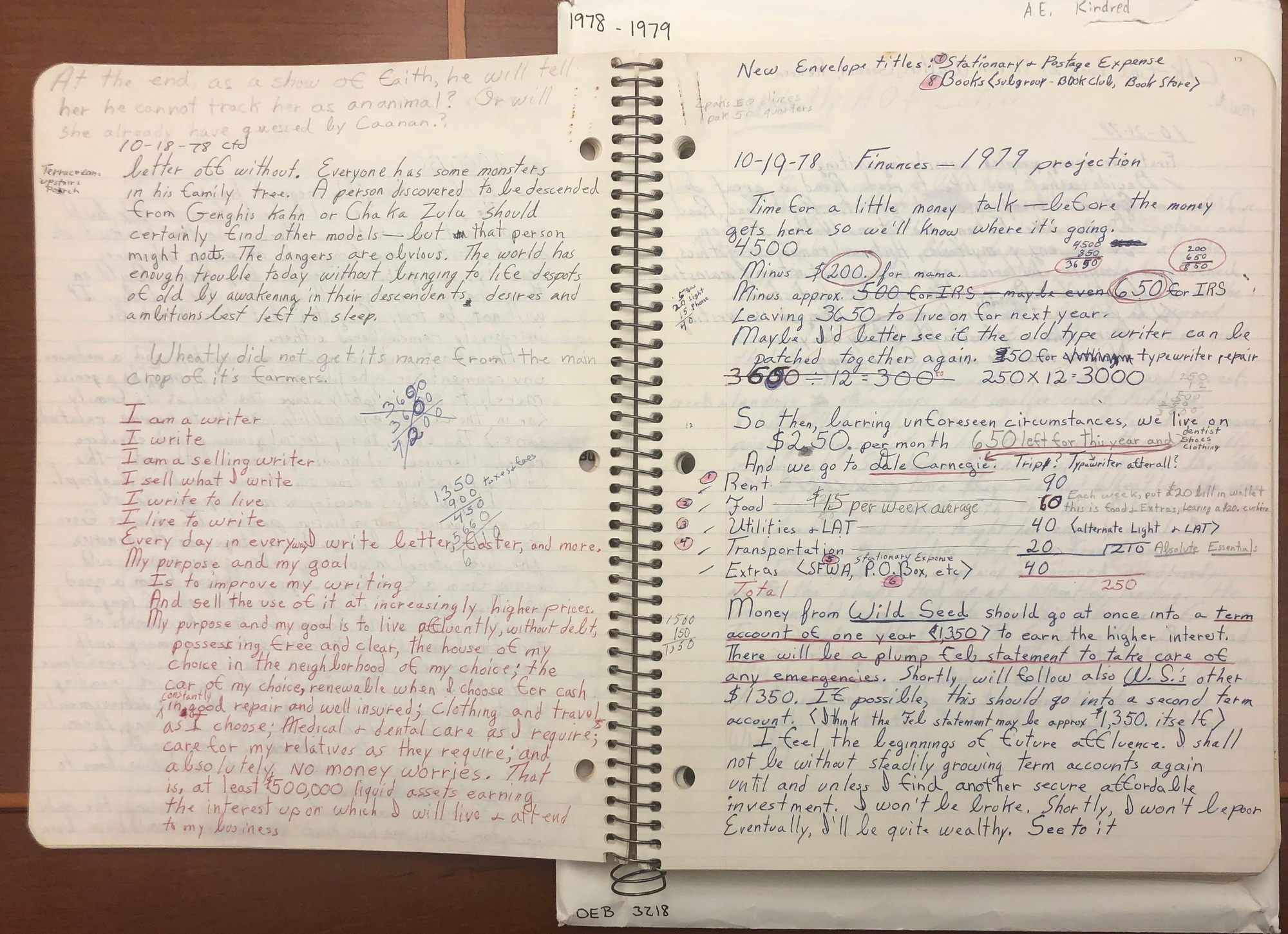
Octavia Butler's notebook with affirmations and financial calculations, 1978. The Huntington Library (OEB 3218)
Photo by Jillian Hess
Commercial success and fame can also present their own obstacles to creation. Amy Winehouse, frustrated with the non-musical obligations of her career — the publicity and marketing side of things — pleaded, ‘Leave me alone and I’ll do it. I will do the music. I just need time to make the music.’8 For Winehouse, as for many artists before her and since, time and space to ‘do the music’ are the very definition of success. ‘Success to me is not success to the record label [i.e., record sales]’, she once said. ‘Success to me is having the freedom to work with whoever I want to work with, to always be able to just fuck everything off and go to the studio when I have to go to the studio’.9 Winehouse’s ‘studio’, with the concomitant freedom to ‘just fuck everything off and go’ to that studio at any time, sounds to me like a version of Woolf’s ‘room’.
This discontent is perhaps both a driver of creativity and an obstacle to artistic work, depending on how it’s managed.
Room, or no room; abundance or shortage of time to go to the studio — there does seem to be a kind of ‘in-built discontent’ that can haunt artists, as pianist Joanna MacGregor has remarked regarding Nina Simone.10 This discontent is perhaps both a driver of creativity and an obstacle to artistic work, depending on how it’s managed. MacGregor observes, ‘the trouble with being as gifted as Nina Simone is that you push yourself even further, don’t you? I mean, you’re never content with what you do.’ Winehouse said, ‘It’s hard to write. Because you can write a million things a day, but it’s hard to write something you’re proud of.’11 Jean Rhys insisted that when she was ‘excited about life’ she ‘didn’t want to write at all’.12 Rhys declared, ‘If I had my life all over again and could choose’, then ‘I’d rather be happy than write’. Joan Rivers said, ‘The minute you’re not angry about things … what are you talking about? I’m furious about everything. Good things don’t always happen to good people and I’m very angry about it. But if I didn’t have the anger … I wouldn’t be a comedian. Anger fuels the comedy.’13 Many artists, in many times and places, have attested to a certain malaise, melancholy or anger that is intrinsic to their practice, their work, their lives and — often, they have claimed — to the human experience itself. While we shouldn’t romanticise ‘suffering for one’s art’, I think we also shouldn’t dismiss wholesale the testimony of numerous artists who (intentionally or not) have done just that.
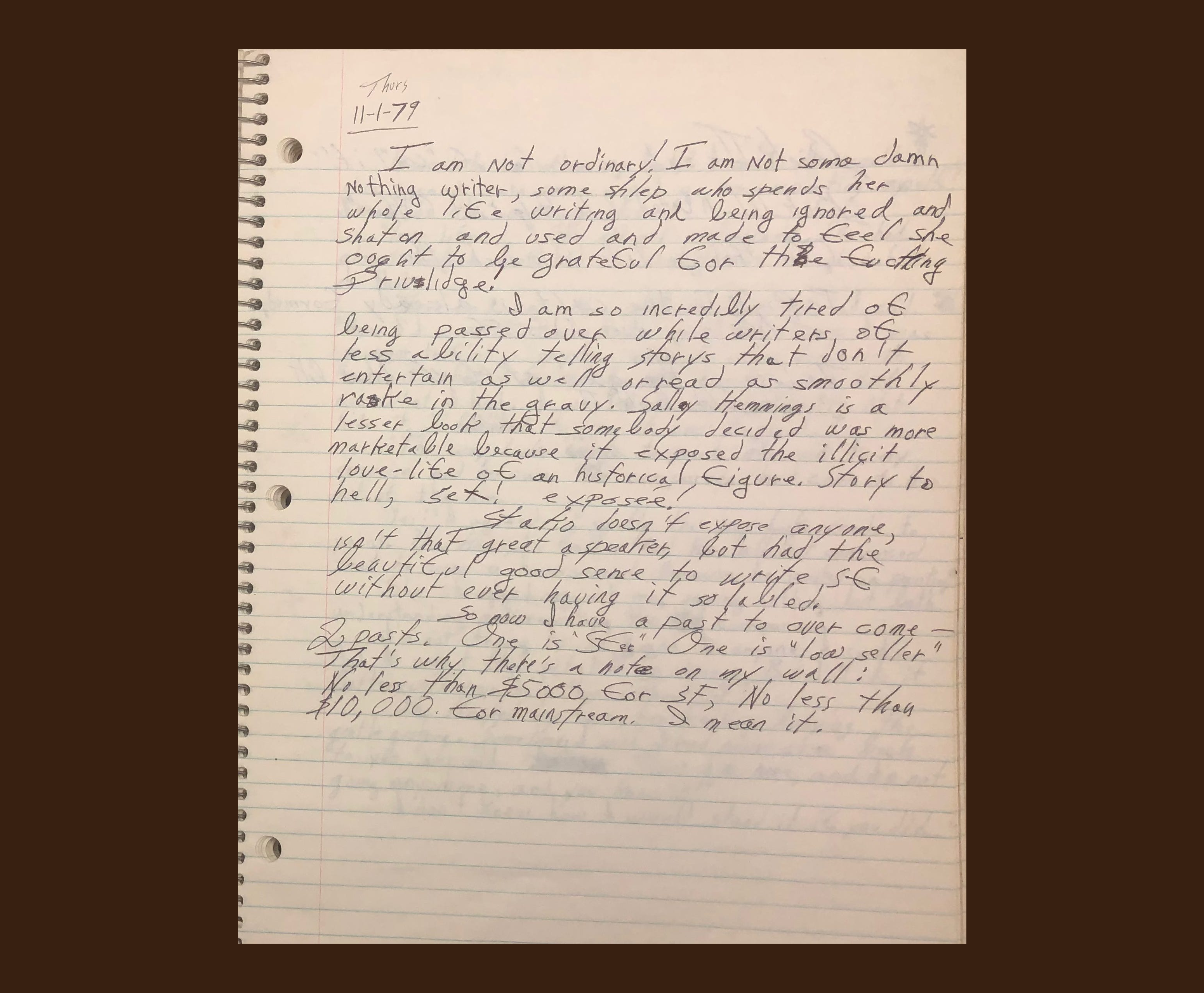
Octavia Butler's notes, 1979. The Huntington Library (OEB 3219)
Photo by Jillian Hess
All this said, if material hardship proves insurmountable it can quash projects and entire bodies of work before other kinds of obstacles even become a factor. Karen Dalton comes to mind: a singer whose talent is now becoming increasingly recognised, she lived her final years in isolation as a ‘social pariah’.14 Her friend Peter Walker has observed that sometime during Dalton’s thirties, ‘the poverty really cut in’ and she ‘was hampered and hindered and handicapped by, more than anything else, the poverty’.15 Walker recounts that Dalton felt ‘people blamed her for not being more successful. She felt that people blamed her for not [recording] more songs and performing more. But she couldn’t. She was …, in a sense, crippled.’16 Reflecting on Dalton, former colleague Nick Hall remarked that ‘a lot of people who are great musicians’ do their ‘best work’ in private.17 He argues that ‘someone like Karen, who was afraid of performing and obviously was uncomfortable with the whole process of any sort of career [is] no less an artist’ than anyone else, because ‘her work was obviously incredibly affecting and strong and powerful’.18 Hall reflects that in some cases, ‘the world must change in order to experience someone’s art’.19
These observations about Dalton resonate with those made in a very different context by classical Hindustani singer, pandit Amiya Ranjan Bandyopadhyay. He explains that ‘someone might sing very well, have a mesmerising voice, brilliant singing style and yet couldn’t become successful. But a lesser artiste becomes successful.’ The pandit concludes, ‘Success comes as a result of one’s publicity skills’, as ‘one who can’t do that, people don’t come to know about him’.20
Which came first, the reality or the iconography?
All these tensions between art practice and art practicalities are real in my experience, but they’re also central to many modern stories of what it means to be an artist. Which came first, the reality or the iconography? In a favourite movie from my childhood, Sister Act 2: Back in the habit (dir. Bill Duke, 1993), an aspiring young singer, Rita Louise Watson (Lauryn Hill), is forbidden from singing by her mother (Sheryl Lee Ralph). Rita’s mother declares, ‘Singing does not put food on the table. Singing does not pay the bills. Singing is no guarantee to a future, even if you have got talent.’ When Rita protests that she ‘can really sing’, her mother replies, ‘Baby, I know how you feel, really I do. But there are a lot of talented people right down there on the street, singin’ their “Shoulda, Coulda, Wouldas.” Is that how you want to end up?’
An artist struggling to make ends meet doesn’t just happen in the movies. It remains commonplace. Siobhan Harvey, winner of the Janet Frame Literary Trust Award for Poetry 2021, recently attested, ‘there are a multitude [of writers] like me who find it impossible to make a living by writing alone’.21 Harvey notes that although she is ‘an author of eight books’ who has ‘won numerous prizes’ and been published internationally, she is financially ‘no better off’ than when she started her career thirty years ago. ‘Indeed, earnings-wise, I’m considerably worse off.’
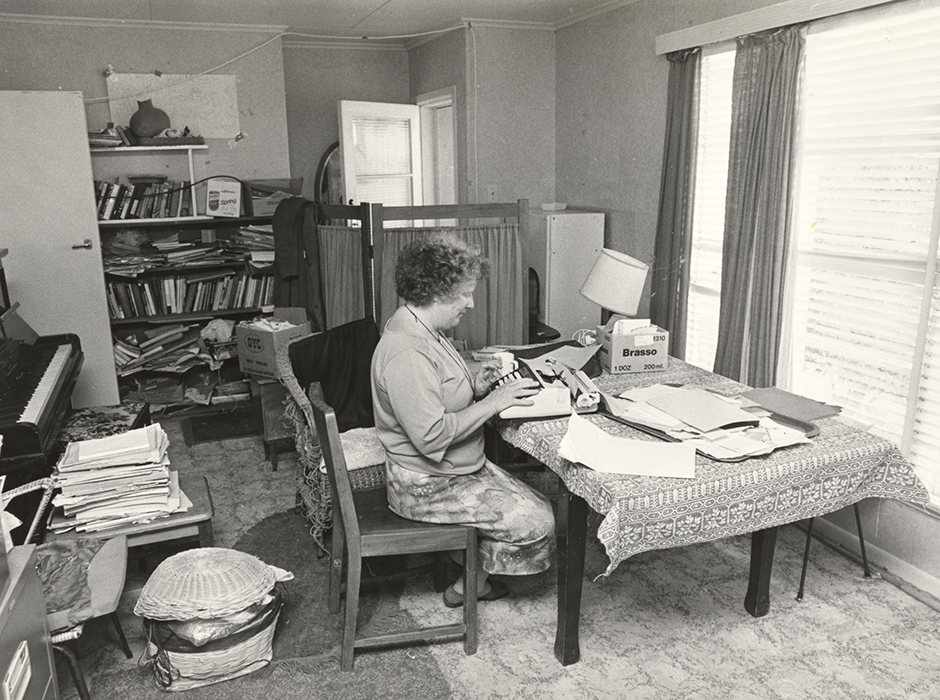
Janet Frame at her desk, Whanganui, 1983. Hocken Collections (MS-3028/807/004)
New Zealand Women's Weekly
Half a century ago, Janet Frame began receiving an annual pension from the New Zealand government. She called it ‘enough to live on’22 and ‘a huge relief’.23 It secured for her a version of the Woolfian ‘room’. It was not easily granted but, in this instance, the ‘world changed’, supporting the second half of a literary oeuvre that is widely regarded as one of the most significant to ever come from a New Zealander. Although it produced excellent results, this methodology for cultivating local art hasn’t, to my knowledge, been repeated since.
The idea of Frame’s pension captures my imagination because it resonates with the temporality of an artistic practice as something living and lifelong — a vocation, perhaps — or a ‘condition’, as James Baldwin characterised it.24 Not really a ‘job’, not even a ‘project’. The current prevailing model for ‘arts funding’ in Aotearoa seems to be oriented towards the paradigm of the ‘project’ but this isn’t necessarily an organic way for artists to think about what they do. Many would claim that their one true project is to simply keep practising, not to make a certain object or perform a certain gig. When I imagine Frame applying for funding on a project-by-project basis, I wonder what those applications would read like, and whether they would be successful. Her novels don’t necessarily sound very worthy, on paper. I wonder if her crowdfunding campaigns would reach their goals and which rewards might be offered on her Patreon? I wonder if a literary pension would have made my tutor happier. What if more writers found more rooms to be their own?
... artistic practice as something living and lifelong — a vocation, perhaps — or a ‘condition’, as James Baldwin characterised it.
The Cabinet paper supporting the proposition of Frame’s pension notes that she ‘has a history of mental instability and such a person needs some security in order to work well’. It also notes that ‘chronic anxiety over money would gravely threaten [Frame’s] health’ because she ‘keeps well largely through the psychological effects of writing’.25 These observations would apply to most artists, at least to some extent — indeed, they would apply to most people. Most artists ‘need some security in order to work well’. And isn’t the health of almost anyone facing ‘chronic anxiety over money’ eventually threatened by the effects of living in that state of affairs? Does the rationale for granting a pension to Frame not apply to many? And if it applies to many, does it not — by the same token — apply to all? Can artists’ worth as human beings ultimately be defined by the ‘value’ of the artwork they produce? If the answer is ‘no’, it stands to reason that the worth of any other group shouldn’t be determined by their work (or lack thereof) either. I am reminded of Baldwin when he says, ‘It seems to me that the artist’s struggle for his integrity’ — and, in Baldwin’s account, part of the artist’s struggle for integrity is simply the struggle to be allowed to work on art, the struggle to resist being forced to ‘get a job’26 — ‘must be considered as a kind of metaphor for the struggle, which is universal and daily, of all human beings on the face of this globe to get to become human beings’.27
Of course, none of us is James Baldwin or Janet Frame or Amy Winehouse or Nina Simone. But don’t stories about renowned artists resonate with aspects of our own lives? Or do we unwittingly bend our lives into the structure of such stories, not because they are really true, but because humans can’t help having our lives shaped by stories?



